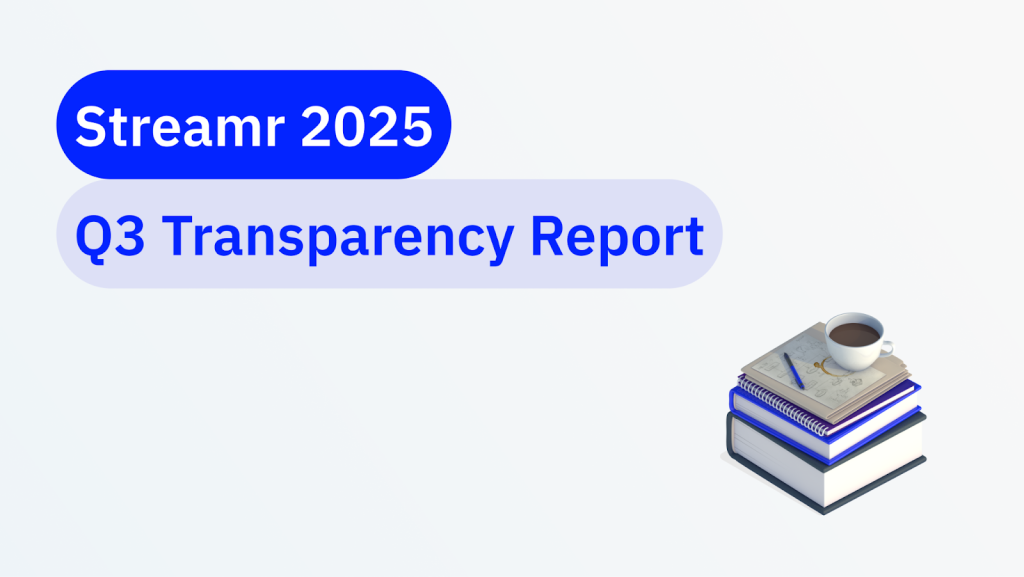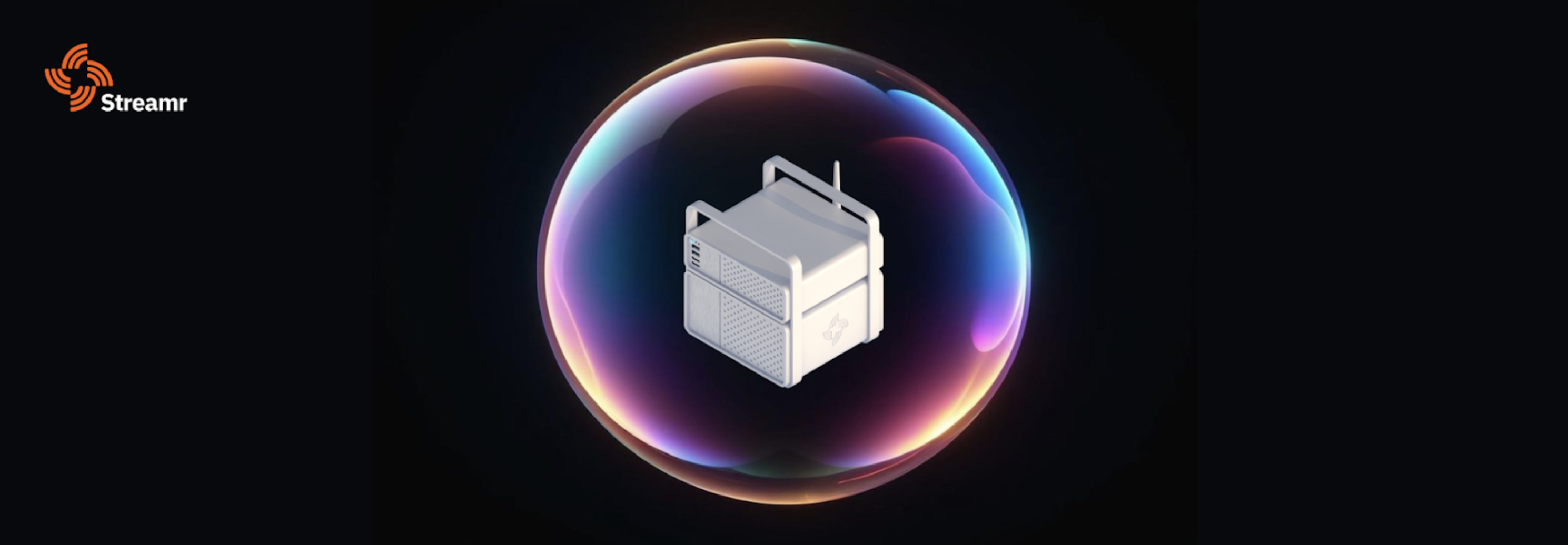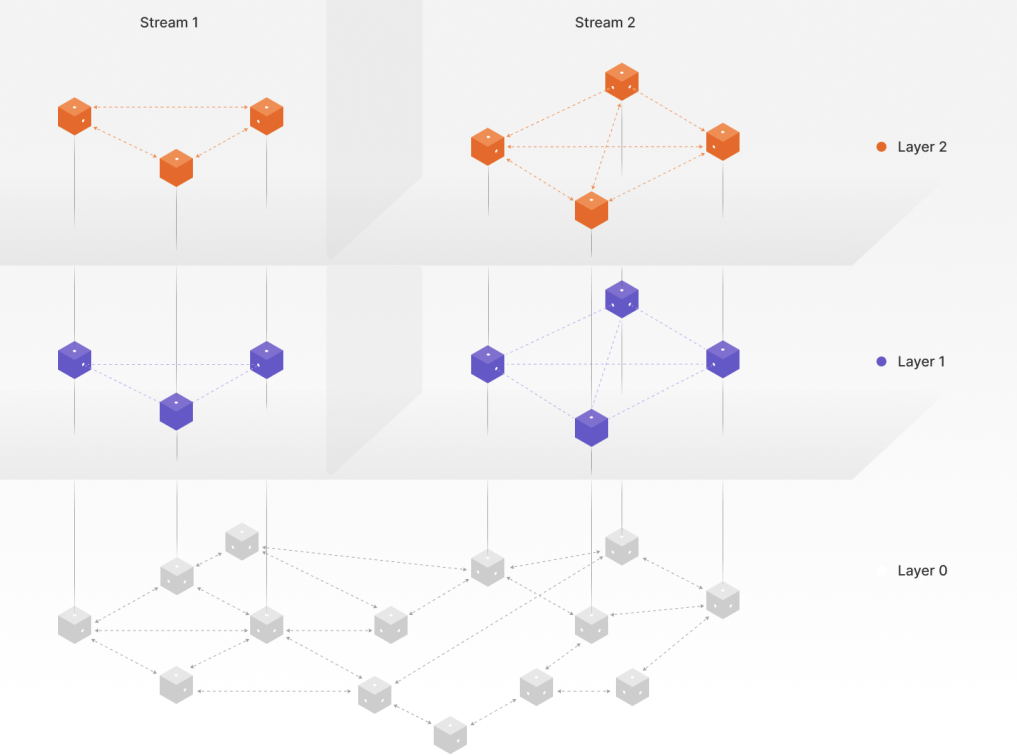It’s been two months since Streamr arrived at its feature complete, 1.0 Mainnet milestone—marking the completion of the original 2017 roadmap. Here’s a recap of what feature complete means to us:
✔️ Censorship resistant publish/subscribe messaging
✔️ Anyone can run nodes
✔️ Builder SDK and Streamr node software
✔️ Browser compatible Streamr nodes
✔️ Multi-layer DHT peer coordination & routing
✔️ Tamper-proof data with data signing & message chaining
✔️ Composable smart contract access control
✔️ End-to-end encryption
✔️ Automatic encryption key exchange
✔️ Decentralized encryption key storage
✔️ Stream partitioning
✔️ Proof of relay node inspection layer
✔️ DATA tokenomics to incentivise Operators
✔️ The Streamr Hub
In other words, Streamr 1.0 is an open and permissionless data streaming network extending the capabilities of the underlying internet without compromising on its decentralized nature. Instead of building yet another closed platform, we are building open data infrastructure, powered by Network Operators, third party builders and their users.
With the 1.0 foundation secured, we’re now ready to begin part two of our journey. Here’s a guide to what to expect in the coming months.
Table of Contents
Product roadmap
We begin with three ambitious upgrades to the Streamr Network: going multi-chain, offering a native low-level client SDK, and supporting flexible data validation. These three upgrades will mean that Streamr will no longer be beholden to any one ecosystem or technology stack. We believe in this product vision because the Internet is inherently vibrant and diverse—for Streamr to be anywhere and everywhere, it needs to be able to adapt to new environments seamlessly.
Multi-Chain Streamr Network
The Streamr Network lives adjacent to blockchain technology and is agnostic to the choice of chain it works with. This upgrade will see new deployments of the Streamr Network on EVM compatible chains. These networks will be independent of each other and serve the builders on that chain. For example, Optimism + Streamr Network, Base + Streamr Network, and so on. Just as blockchains need oracle infrastructure, blockchains need data infrastructure to support their builders. This upgrade will close that infrastructure gap.
Later this year will see the launch of Streamr SDK within the Peaq Network stack. This is a key distribution channel that will see increasingly more DePINs adopt Streamr tech.
Native Streamr SDK
We have begun work on a C++ native Streamr SDK. Not only is this the most requested feature from our ecosystem, but it’s also the way to get Streamr baked into the things of the Internet. Phone apps, smart TVs, DePIN hardware—it all gets unlocked with the delivery of the native Streamr SDK. The native SDK will also allow Streamr to be used more easily from any programming language.
Flexible data validation
On Streamr, every data point is signed at the source by the publisher to offer tamper proof guarantees, i.e. proving with math that this data came from a particular device or person. The Streamr protocol uses secp256k1, consistent with Ethereum, to sign data payloads, but Streamr is not limited to any particular cryptography.
As a first example of this, we’re working to enable the use of PeaqID key pairs, which borrow from Substrate cryptography and are used in the Peaq ecosystem and commonly deployed on devices in DePIN networks. Such key pairs can soon sign and validate messages on Streamr as well as hold publish and subscribe permissions on streams.
Protocol adoption
Getting Streamr nodes in as many browsers, computers, and IoT devices is the clear adoption target we’re working towards. With every new app that integrates the Streamr SDK, comes new streams, more data and more nodes for the Streamr Network.

DePIN
Streamr Network’s serverless, secure, scalable, and plug-and-play framework is ideal for decentralized physical infrastructure networks, i.e. the DePIN revolution. Streamr, a network powered by a global community running nodes on their devices can be considered a DePIN infrastructure pioneer, positioning it well for adoption in this sector.
The core Streamr development team will be helping to support new proof of concepts with these DePIN partners, potentially contributing to their own project roadmaps, developing technical integrations when needed.
Video
Video streaming costs on the Internet are prohibitive for many since costs scale linearly with viewers. Streamr powered players turn viewers into the distribution network. As they watch the content, they also share the content with other viewers. This reduces the reliance on centralized servers, saves bandwidth, and improves scalability.

In this respect, Streamr technology is a gamechanger. By sharing the load of a video stream across a mesh network on Streamr, the streaming costs can be dramatically lowered. Streamr Operators will be pivotal, forming a backbone of distribution, much like a CDN.
Be one of the first to try out this new technology and earn $DATA in the process!
AI
Earlier we wrote about the era of real-time generative intelligence and more recently released StreamGPT—the first AI agent launched on the decentralized network.

Streamr’s position with respect to AI is clear: it allows for AI models to interconnect, share insights, plug into real-time tuning data, distribute content, and collectively enhance their intelligence. Integrating with a decentralized framework can also provide a step towards ensuring AI operations are more open, verifiable, and up to date, which will be valuable to safeguard against the rapid, and potentially dangerous, pace of competition driven advancement.
Put simply– Streamr will become the transport layer of AI inference.
Streamr Node Operators
The launch of Streamr 1.0 ushered in two new roles: Operators and Delegators. After only two months, over 100M DATA tokens have been staked on Operators. This stake represents the Network’s promise of delivering reliable bandwidth for data streaming use cases.

What comes next for Operators is more organic and dynamic demand for their bandwidth. This will be driven by the compounding effects of all of our adoption efforts. Beside more work and rewards for Operators, the core development team will continue to build better tooling, and more engaging sponsorship opportunities for the Operator community. In effect, every product, service and gateway business built on the application layer of Streamr will be generating demand for Operator services.

Ecosystem engagement
Working closely with our partner ecosystem helps us to steer the project towards solving relevant problems in Web3 and beyond.
While the Streamr ecosystem is primarily infrastructure aimed towards the application layer, many use cases require data to be stored and later retrieved with requirements that go beyond our (primarily) real-time data network. Instead of trying to build it all, we are moving towards a decentralized data stack—an ecosystem of decentralized storage systems and providers, allowing stream owners to choose how and where to store their data. One such example of this is the LogStore Network—capable of extending the Streamr Network with caching and long term storage. This is possible because open protocols are composable and share the same vision for permissionless and decentralized infrastructure.
Gateways– The path to mass adoption
Gateways are businesses built on top of Streamr Network that abstract away the token management and other Web3 native UX hurdles. Gateways provide end users with fiat pricing, SLAs, customer support, and value-add features with a Web2 UX that they’re familiar with.

The first of such gateway businesses is Subcast, focused on the live video streaming use case. Subcast aims to bridge the gap between protocol and product—to streamline mass adoption for the Operator economy by building on the competitive advantage that Streamr technology brings versus high margin SaaS companies.
Given that Streamr is general purpose data infrastructure, many different gateway businesses could flourish in the future across many different verticals. What’s important to us is that these gateway businesses feed into the Operator economy and are aligned with the DATA tokenomics at the protocol level.

Onwards!
There will be a follow-on Part 2 to this post, going into detail about the protocol hardening measures we’ll be taking in the future, beyond what we’ve covered here.
A big thank you to everyone that’s supported our vision, to those that have joined our testnets, reported bugs, have started an Operator business or delegated to one. It’s a community effort to bring a peer-to-peer network into the mainstream. We look forward to showing off what Streamr can do for the growth of the Internet and sharing that journey with you.
Let the push for adoption begin!











